Deconsolidation and combustion performance of thermally consolidated propellants deterred by multi-layers coating
Zheng-gang XIAO*,San-jiu YING,Fu-ming XU
School of Chemical Engineering,Nanjing University of Science and Technology,Nanjing 210094,China
1.Introduction
Consolidated propellants were initially studied for caseless ammunition and subsequently shifted into the area of high loading density cased ammunition[1-3].They can improve the ballistic performance by increasing the propellant charge mass and enhancing the progressivity resulting from the increase in surface area during the deconsolidation process.
Several methods can be used to consolidate the loose granular propellants to the consolidated or compact propellants.The direct compaction method was applied by Olin Corporation to develop a process for in-case compaction of ball powder propellant[4].Vapor solvation technique is another important consolidated method[3].The acetone or other solvent is absorbed on the surface of propellant grains.The swollen propellant grains are pressed to the predesigned shape and size in the mold.The most important factor that affects the combustion characteristics is the grain distortion due to consolidation and charge breaking up into grain aggregates rather than individual grains.The deconsolidation of consolidated propellants needs more controlled breakup to the individual grains.Therefore,the thermal consolidation process used by Veritay Technology Inc[5]was developed to eliminate the problems associated with solvent-based methods.Consolidation was performed using extruded-grain propellants that are coated with a heat-activated binder.The binder may be energetic in promoting or inhibiting the combustion of propellants.The binder coating on the grains could act as a chemical deterrent as well.Since the propellants are heated during the consolidation process,grain fracture is essentially eliminated.
Consolidated propellants will burn through or fracture into smaller aggregates or individual grains once ignited.All the deconsolidated process is dependent on pressure.However,it is disappointing to note that the most charges begin to deconsolidate at a relative low pressure.Also the deconsolidated process is too long to obtain higher progressivity.
The influences of different consolidation techniques on constant-volume combustion characteristics of Triethyleneglycol dinitrate(TEGDN)propellant were investigated to obtain the optimized consolidation method in previous study[6,7].Results showed that the combination technique of consolidation and surface treatment has good prospect for application in propellant charge.
This paper investigated a new thermal consolidation and subsequent coating technique combining the thermal heating with solvent-spray.The consolidated propellants were coated with a slow burning layer.The macro progressivity can be obtained by increasing both the burning area and burning rate from the outer slow burning coating layer to the inner consolidated propellant layer during deconsolidation and combustion.
2.Experiment
2.1.Propellants
The samples for consolidation are double-base oblate sphere propellant standard grains plasticized with triethyleneglycol dinitrate(TEGDN)(TEGDN propellants).Their average web thickness is 1.6 mm.Anatase nano-TiO2(100 nm in average diameter)was provided by Nanjing Haitai Nanomaterials Cooperation,Jiangsu,China.
2.2.Consolidation process
In the new thermal consolidation and subsequent coating method proposed in this study,the TEGDN propellants are initially heated to 75 C,and then put into a mold to consolidate to predesigned shape and density.During the consolidation process,the temperature is kept at 75 C.At the same time,the surfaces of TEGDN propellant grains are softened using pure acetone vapor or pure ethanol liquid sprayed from a nozzle.The percentage of pure acetone or ethanol solvent is 10%(wt%)of TEGDN propellant grains.The loose TEGDN propellant grains are pressed into a cylinder with 38 mm in height and 16 mm in diameter or other shapes according to the experimental requirements,producing the samples with three compaction densities:1.20,1.35 and 1.39 g/cm3.And the consolidation pressure is held at 20 MPa for 5 min.The three different compaction densities are controlled by pressing the different consolidated propellant mass into a cylinder with same size.The pressed cylinder is coated with TiO2/NC gel and pure NC gel and dried in an oven at 30 C for 1 day and 50 C for 8 h,respectively.TiO2/NC and pure NC gels are dispersed in the mixed solvent of 50%acetone and 50%ethanol,respectively.The mixed gel coating has 2 layers for the easier coating processing.The total thickness of deterred NC multi-layers is in the range from 0.11 mm to 0.41 mm.An example of the consolidated propellant coated with deterred multi-layer coating is shown in Fig.1.
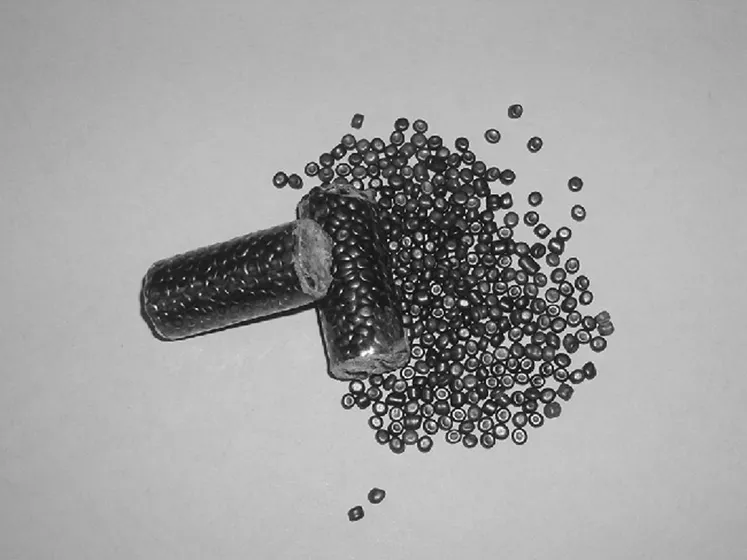
Fig.1.Consolidated propellants deterred by multi-layer coating.
Table 1 lists the grain dimensions and compaction density after consolidation.The mass of each consolidated propellant cylinder is about 8 g.The related parameters of consolidated propellants prepared by direct compaction method and solvent vapor method are also listed in Table 1.The maximum compaction density of deterred and coated consolidated propellants can reach up to 1.39 g/cm3.
2.3.Methods and set-up
An axial compression test is carried out to determine the deformation behavior of consolidated propellant grains under certain loads using Model 3367 Instron Materials Testing Machine at ambient temperature.The specimen is compressed,and its deformation at various loads is recorded,as similar to the method in Ref.[8].
The interrupted burning experimental set-up and experimental method are the same with the set-ups and experimental methods reported in Refs.[9,10].The blow-out pressure of interrupted burning experimental set-up is controlled by the thickness of shear disc.The shear disc should be selected to ensure the interrupted burning of burning propellant grains at the required pressure level.At a certain pressure,the shear disc ruptures.Rapid extinguishment of burning propellants occurs due to sudden depressurization.At the same time,the maximum pressure is referred as rupture peak pressure.It should be mentioned that the rupture peak pressure is not always of the same value because the shear disc is not uniform in material microstructure.The thickness of shear disc used in the experiment is 2.5 mm.Accordingly,the blow-out pressure is about 104±10 MPa,as recorded by the pressure transducer.
The closed bomb burning tests of consolidated charge were performed using a 200 ml experimental set-up as similar to that in Ref.[11].Four TEGDN consolidated propellantcylinders(about 32 g)are put into the set-up for each test round.Experimental loading density is 0.16 g/cm3.

Table 1Sizes and compaction densities of consolidated propellants prepared by three kinds of consolidation techniques.
3.Results and discussion
3.1.Influence of consolidation techniques on mechanical performance
Compressive stress and strain were calculated and plotted as a stress-strain curves,as shown in Fig.2.The symbol(a)denotes the control sample consolidated by the direct compaction method.The symbol(b)denotes the consolidated propellants coated with NC gel consolidated by the solvent vapor method.The symbol(c)denotes the consolidated propellants coated with NC gel layer consolidated by thermal consolidating and subsequent coating techniques investigated in this paper.The stress-strain curves of sample coated with NC/TiO2mixed gel in Fig.2 are similar to the above curves.
As shown in Fig.2,the compression strength of tested sample prepared by the traditional methods ranges between 3 and 8 MPa.Obviously,it is easily broken to aggregate and grains once ignited.Since the consolidated propellant prepared by the direct compaction method has no surface deterred layer,its strength is lower than that consolidated by the solvent vapor method.However,the compression strength of sample increases significantly to 18 MPa when the surface of thermal consolidated propellants is deterred by the slow burning NC multi-layer coating,indicating that the thermal consolidated charge can be applied in most circumstances of charge service.The thermal consolidation process is apt to increase the adhesion strength between the propellant grains.
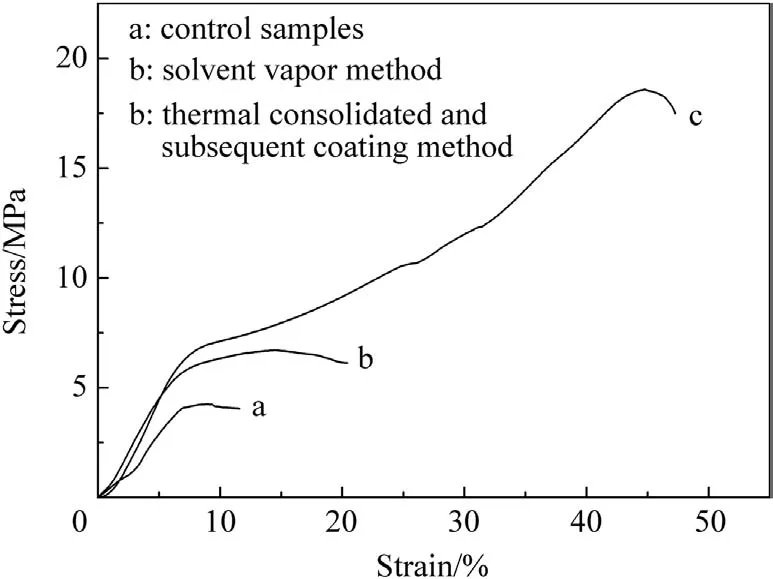
Fig.2.Stress-strain curves of consolidated propellants prepared by three kinds of consolidation processes.
3.2.Influence of coated layer on deconsolidation of consolidated propellants
The deconsolidation process of consolidated propellants can be observed by the interrupted burning experiment based on the experimental results of the static mechanical compression.The deconsolidation processes of consolidated propellants prepared by three kinds of thermal consolidation methods listed in Table 1 were observed under the same experimental condition.TiO2/NC mixed gel and NC gel are used in the deterred process of new consolidated techniques,respectively.
The recovered propellant aggregates of the control sample consolidated by the direct compaction method and the consolidated propellants deterred by two kinds of gel coating are shown in Figs.3-5,respectively.The photos shown in Fig.3-5 just provide a brief observation of recovered propellants,but the experimental process provides much additional information on the deconsolidation process.In all cases,there are varying degrees of grain deconsolidation but there are only 1%fractured grains.As shown in Fig.3,the number of aggregates of control sample is very few,indicating it easily breaks up into many grains at blow-out pressure of 104 MPa.However,the consolidated propellants deterred by NC gel layer at the same condition is deconsolidated to larger aggregates and grains due to its stronger mechanical strength.When the coating layer is changed into TiO2/NC mixed gel,the larger aggregates are produced during the deconsolidation of consolidated propellants.The deterred samples coated with TiO2/NC mixed gel are much more difficult to deconsolidate due to its difficulty to ignition than ones coated with NC gel layer.The experimental results of consolidated samples coated with deterred layers with different thickness are similar to those above.The thicker the deterred multi-layer coating is,the harder the deconsolidation of the sample is at the beginning stage.
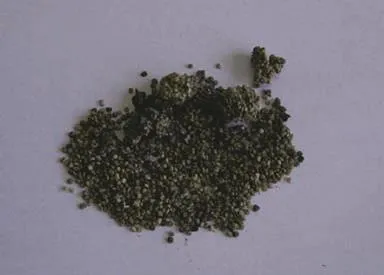
Fig.3.Recovered propellant aggregates and grains of control samples.
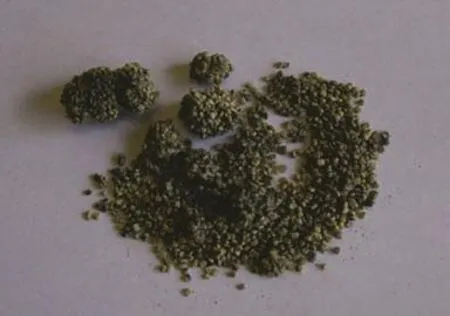
Fig.4.Recovered propellant aggregates and grains of consolidated propellants deterred by NC gel layer.
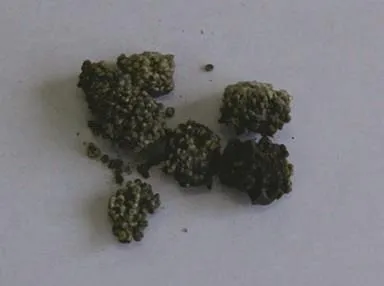
Fig.5.Recovered propellant aggregates and grains of consolidated propellants deterred by TiO2/NC mixed gel layer.
3.3.Influence of coated layer thickness on the combustion performance
The pressure-time history(p-t curve)of consolidated propellants burning in a closed vessel is shown in Fig.6.The dp/dt-t curves are shown in Fig.7.The dynamic vivacity L at the relative pressure B of consolidated propellants is shown in Fig.8.
Dynamic vivacity can be derived from the closed vessel pressure history and defined as

Relative B is defined as

where pmis the maximum pressure in the closed bomb test.
As in Ref.[12],the dynamic vivacity depends on the propellant compositions and actual burning surface area.It has been used to assess the geometric progressivity of propellant and the fracture degree of propellant surface area.
As shown in Figs.6-8,a significant turning point exists in p-t,dp/dt-t and L-B curves of propellant charge consolidated using the thermal consolidated and subsequent method.The symbol(a)denotes the control samples without coating layer,the symbol(b)denotes 0.11 mm thick NC gel layer,the symbol(c)denotes 0.35 mm thick NC gel layer,and the symbol(d)denotes the samples firstly deterred by 0.21 mm thick NC gel layer and then coated with the TiO2/NC mixed gel.The total layer thickness is about 0.41 mm.It is very obvious that the consolidated propellants deterred by TiO2/NC mixed gel multi-layer coating indicates a two-stage combustion phenomenon due to thicker coated multi-layers and slower burning rate in outer TiO2deterred layer.A step exists on the dynamic vivacity curve when relative pressure is about 0.25.The step on the dynamic vivacity curve shows the rapid deconsolidation process of consolidated propellants.After the outer multilayers of consolidated samples were finished burning,the inner consolidated propellants continued to burn and deconsolidated into aggregates and grains during the subsequent process.As shown in Figs.6 and 8,the initial deconsolidation pressure of consolidated propellants coated with TiO2/NC mixed gel multi-layers is about 58 MPa,which is higher than the reported research results of 42 MPa[3].And the charge completely deconsolidated in the pressure range from 58 MPa to 82 MPa.The deconsolidation pressure distribution range length is about 20 MPa,which is narrower than the reported research results of 30 MPa[3].Obviously,the deconsolidation process and duration can be carefully controlled by the thickness of coated multi-layers for the purpose of high progressive burning.

Fig.6.Pressure-time history of consolidated propellants deterred by coating layers with different thicknesses,a)without coating layer;b)0.11 mm;c)0.35 mm;d)0.41 mm.
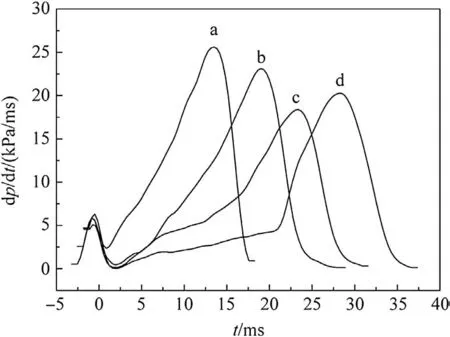
Fig.7.dp/dt-t curves of consolidated propellants deterred by coating layers with different thicknesses,a)without coating layer;b)0.11 mm;c)0.35 mm;d)0.41 mm.
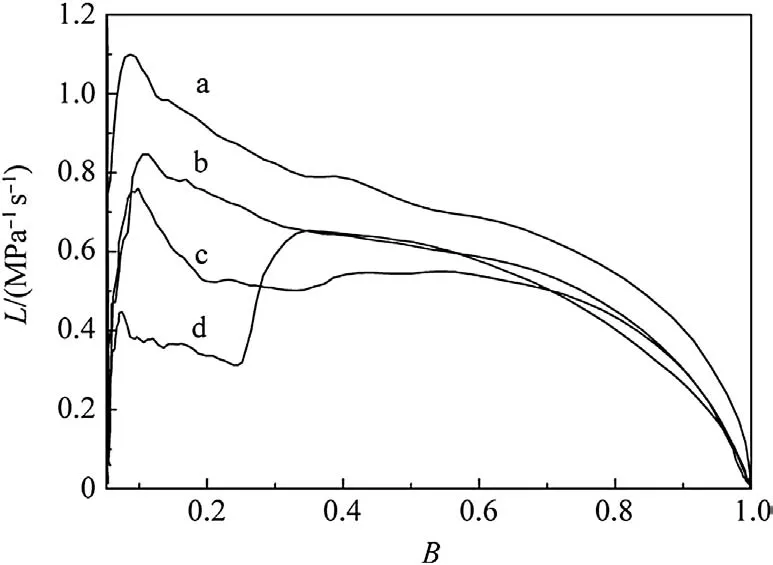
Fig.8.Dynamic vivacity via relative pressure curves of consolidated propellants deterred by coating layers with different thicknesses,a)without coating layer;b)0.11 mm;c)0.35 mm;d)0.41 mm.
4.Conclusions
High density and high progressive consolidated propellants can be prepared by the thermal consolidation and subsequent coating techniques.The maximum density of deterred and coated consolidated propellants can reach up to 1.39 g/cm3.The consolidated propellants can significantly increase the charge energy.The static compression strength of deterred and coated consolidated propellants can reach up to 18 MPa,indicating that they can be handled conveniently during the cartridge charging process.The propellant charge consolidated using new methods deconsolidates rapidly after the outer layer is finished burning.The thicker the deterred multi-layer is,the harder the deconsolidation of the sample is at the beginning stage.Two-stage combustion can be observed during the deconsolidation and combustion process.The deconsolidation process and duration of consolidated propellants can be controlled concurrently and carefully by the thickness of multi-layer coating for the purpose of high progressive burning.The results show that the consolidated propellants can rapidly deconsolidate at higher deconsolidation pressure.Higher density and higher macro progressivity of consolidated propellants can be obtained by the techniques in this paper,while the deconsolidated process can be controlled.
This work was supported in part by the National Natural Science Foundation of China(No.51376092).
[1]Juhasz AA,May IW,Aungst WP,Doali JO,Bowman RE.Combustion characteristics of consolidated propellants.In:Proceedings of the 16th JANNAF combustion meeting.Monterey,California;September 10-14,1979.
[2]May IW,Juhasz AA.Combustion processes in consolidated propellants.Aberdeen Proving Ground,MD:U.S.Army Ballistic Research Laboratory;1981.ARBRL-MR-03108.
[3]Doali JO,Juhasz AA,Bowman RE,Aungst WP.Combustion characteristics of consolidated propellants resulting from different consolidation techniques.Aberdeen Proving Ground,MD:U.S.Army Ballistic Research Laboratory;1988.BRL-TR-2944.
[4]Martin R,Gonzalez A.Applications of compacted ball powder propellant in medium caliber ammunition.In:Proceedings of the JANNAF propulsion meeting.Monterey,California;November 15-19,1993.
[5]Cloutier T,Sadowski L.Development of a lightweight ammunition concept using an alternative case material and enhanced propellant.Picatinny,New Jersey:Armament Research,Developments and Engineering Center,Armaments Engineering and Technology Center(Benet);2005.ARAEW-TR-05006.
[6]Xiao Z,Ying S,Xu F.Influence of consolidated technique on constantvolume combustion characteristic of consolidated TEGN charge.Chinese Journal of Ballistics 2009;21(4):92-4.
[7]Xiao Z,Ying S,Xu F.Experimental studies of interrupted burning characteristics and deconsolidation performance of consolidated propellant charge.Chinese Journal of Ballistics 2013;25(3):70-4.
[8]Bonnet C,Pieta PD,Reynaud C.Investigations for modeling consolidated propellants.In:Proceedings of the 19th international symposium of ballistics.Interlaken,Switzerland;May 7-11,2001.
[9]Xu F,Wang Z,He W.Propellant grains with similar material coatings:the effect of their low temperature sensitivity and the laboratory prediction method.In:Proceedings of the 28th international pyrotechnics seminar.Adelaide,Australia;Nov 4-9,2001.
[10]Xiao Z,Xue A,Ying S,He W,Xu F,Hou B.Experimental studies of propellant loading parameters and plasma flow-field interactions.IEEE Transactions on Magnetics 2009;45(1):514-7.
[11]Wagner T,Ritter J,Homan BE.Upgrades to the closed bomb facility and measurement of propellant burning rate.Aberdeen Proving Ground,MD:U.S.Army Research Laboratory;2010.ARL-TR-5058.
[12]Oberle WF.Dynamic vivacity and its application to conventional and electrothermal-chemical(Etc)closed chamberresults.Aberdeen Proving Ground,MD:U.S.Army Research Laboratory;2001.ARL-TR-2631.
- Defence Technology的其它文章
- Shock tube design for high intensity blast waves for laboratory testing of armor and combat materiel
- A passive method to stabilize an airborne vehicle
- Experimental investigation of a cook-off temperature in a hot barrel
- Formulation development and characterization of cellulose acetate nitrate based propellants for improved insensitive munitions properties
- Burning characteristics of microcellular combustible objects
- Dynamic analysis of a guided projectile during engraving process

